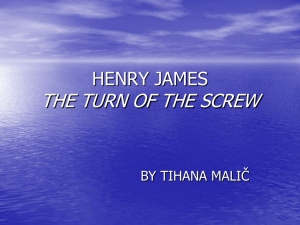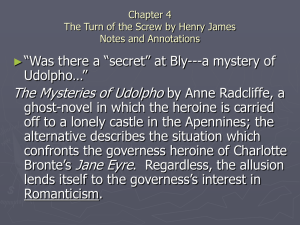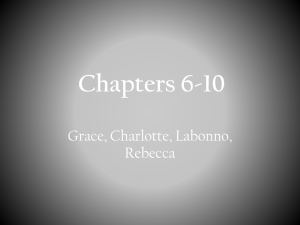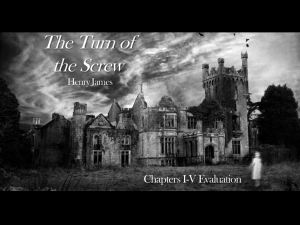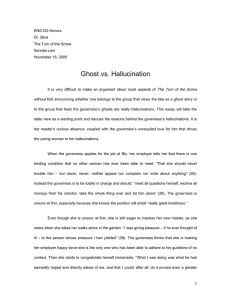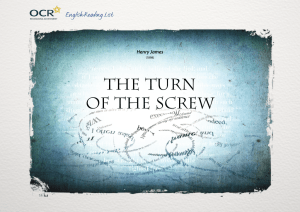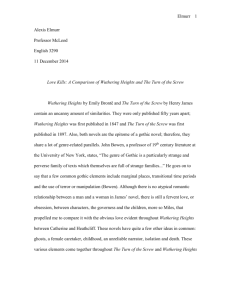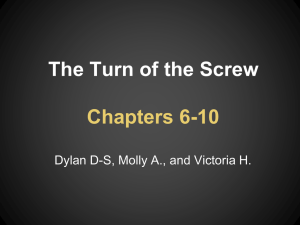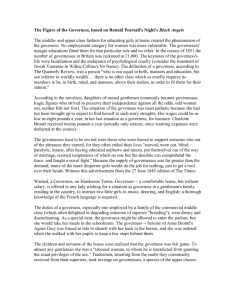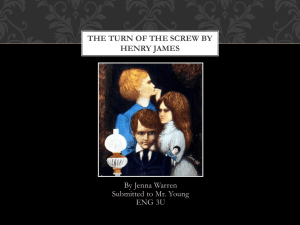The Turn of the Screw - LaGuardia ePortfolio
advertisement
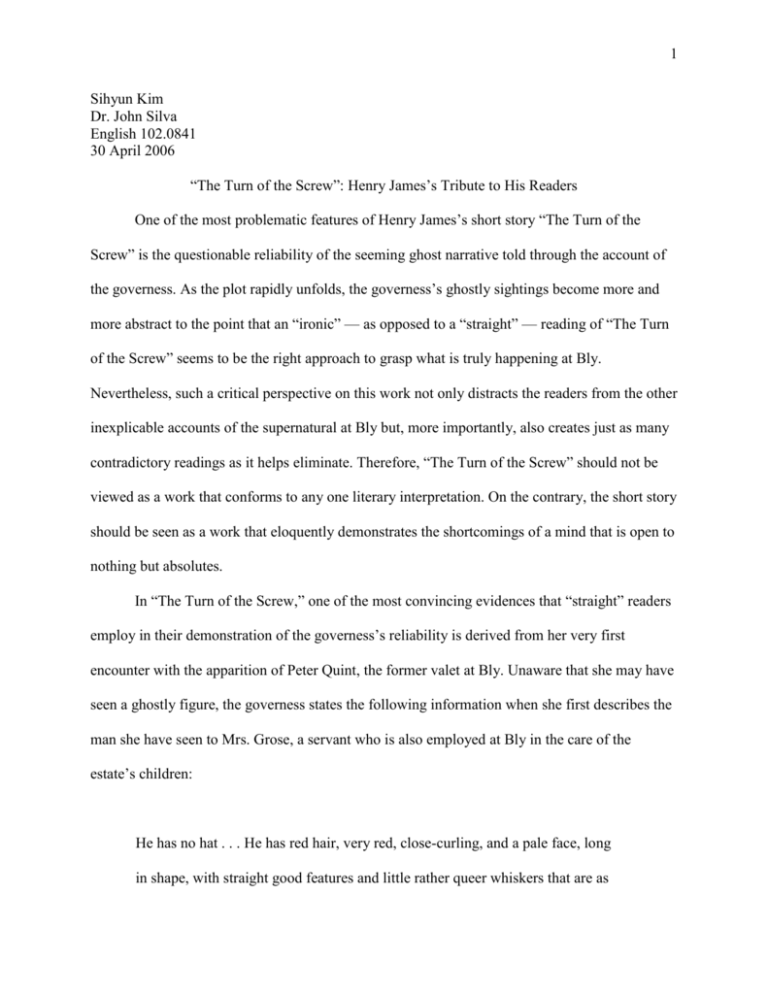
1 Sihyun Kim Dr. John Silva English 102.0841 30 April 2006 “The Turn of the Screw”: Henry James’s Tribute to His Readers One of the most problematic features of Henry James’s short story “The Turn of the Screw” is the questionable reliability of the seeming ghost narrative told through the account of the governess. As the plot rapidly unfolds, the governess’s ghostly sightings become more and more abstract to the point that an “ironic” — as opposed to a “straight” — reading of “The Turn of the Screw” seems to be the right approach to grasp what is truly happening at Bly. Nevertheless, such a critical perspective on this work not only distracts the readers from the other inexplicable accounts of the supernatural at Bly but, more importantly, also creates just as many contradictory readings as it helps eliminate. Therefore, “The Turn of the Screw” should not be viewed as a work that conforms to any one literary interpretation. On the contrary, the short story should be seen as a work that eloquently demonstrates the shortcomings of a mind that is open to nothing but absolutes. In “The Turn of the Screw,” one of the most convincing evidences that “straight” readers employ in their demonstration of the governess’s reliability is derived from her very first encounter with the apparition of Peter Quint, the former valet at Bly. Unaware that she may have seen a ghostly figure, the governess states the following information when she first describes the man she have seen to Mrs. Grose, a servant who is also employed at Bly in the care of the estate’s children: He has no hat . . . He has red hair, very red, close-curling, and a pale face, long in shape, with straight good features and little rather queer whiskers that are as 2 red as his hair. His eyebrows are somehow darker; they look particularly arched and as if they might move a good deal. His eyes are sharp, straight — awfully; but I only know clearly that they’re rather small and very fixed. His mouth’s wide, and his lips are thin, and except for his little whiskers he’s quite cleanshaven. He gives me a sort of sense of looking like an actor. (48) The fact that the governess is able to provide such a meticulously detailed account of her encounter with Quint before the revelation of his identity by Mrs. Grose seems to provide enough proof in support of the governess’s reliability. After all, how else would she have been able to provide such an objective description of a man whom she has never met? Nevertheless, a closer reading of the early chapters of “The Turn of the Screw” reveals that James could have inserted possible clues concerning the governess’s unreliability. When the governess and Mrs. Grose engage each other in a conversation regarding the previous governess, Miss Jessel, Mrs. Grose inadvertently displays a possibly Freudian slip of the tongue: “Oh he did,” Mrs. Grose assented: “it was the way he liked every one!” She had no sooner spoken indeed than she caught herself up. “I mean that’s his way — the master’s.” I was struck. “But of whom did you speak first?” She looked blank, but she coloured. “Why of him.” “Of the master?” “Of who else?” (35) 3 Even though the name “Peter Quint” is never openly mentioned by Mrs. Grose, the strikingly observant governess immediately picks up on her slip, concluding that the man Mrs. Grose has described is not their employer. While arguing that the governess hereafter will begin to associate Bly with a sexually promiscuous man is a bit of a stretch, this seemingly innocuous conversation between the two women provides the “ironic” readers with some grounds in asserting that the governess’s encounters with the ghosts are not mere random occurrences. On the contrary, the ghostly apparitions that the governess will continuously claim to have seen can be deemed as a platform through which she reveals her subconscious thoughts and desires. Without a doubt, the governess’s tendencies to instill her own private beliefs and preconceptions into her account of ghostly encounters become dramatically clear after the discovery that the man she has seen is none other than the late Peter Quint. The governess’s sudden plunge into subjectivity cannot be better shown than through her passionate outbursts in which she finds herself immersed when she discovers that there are not one, but two ghosts at Bly: “Another person — this time; but a figure of quite as unmistakeable horror and evil: a woman in black, pale and dreadful — with such an air also, and such a face!” (56). In sharp contrast to her earlier account of Peter Quint, the governess’s descriptions of the apparition of Miss Jessel transcend what can be gathered through her five senses alone. This rationale as exercised by the governess is certainly quite erratic and ironically leads her into conflict with those whom the governess desperately tries to save in the midst of all the evils at Bly — Flora and Miles: “Two hours ago, in the garden” — I could scarce articulate — “Flora saw!” 4 Mrs. Grose took it as she might have taken a blow in the stomach. “She has told you?” she panted. “Not a word — that’s the horror. She kept it to herself! The child of eight, that child!” Unutterable still for me was the stupefaction of it. (55) The governess unreasonably concludes through Flora’s silence that the children are already quite familiar with the existence of the ghostly figures of Quint and Jessel. Surely, such logic is prone to disarray since whatever the children say or do not say must be scrutinized by the governess. Therefore, it is no surprise that her relationship with the children will hereafter quickly deteriorate. But more importantly, the fact that the governess by now has fully demonstrated her unreliability as a narrator should more than sufficiently support the argument that “The Turn of the Screw” should not be viewed as a “straight” ghost story, but rather as an “ironic” psychological thriller. However, merely addressing the issue of whether the ghosts themselves are truly real does not adequately account for the other signs of the supernatural at Bly. For instance, how can one rationalize the following list of facts: (1) Miles’s mysterious expulsion from school; (2) Miles’s bizarre extinguishing of the candle in chapter seventeen; and (3) Flora’s preternatural ability to row a large boat across a pond in chapter nineteen? After providing a long list of evidences to disprove the reliability of the governess, the “ironic” reader seems to have reached a dead end. Nevertheless, according to Sheila Teahan, an associate professor of English at Michigan State University who has written numerous articles on Henry James’s works, all readings are inherently “partial and incomplete”: they emphasize “some textual evidence while ignoring other evidence in the interest of advancing a particular theory about the text” (362). 5 “The Turn of the Screw,” in other words, should not be so hastily perceived as a work that permits the existence of only one “correct” interpretation. On the contrary, what one should ultimately learn from James’s short story is that, at times, multiple readings that appear incompatible can be equally supported by the very same text. In short, a reader who strictly adheres to an “ironic” reading in his or her understanding of “The Turn of the Screw” will eventually realize that such a rigid approach creates just as many problems as a downright “straight” reading does. Indeed, Teahan points out that one of the biggest sources of frustration that readers face is the fact that the story is told through a frame narrative: “[t]he governess’s narrative is thrice mediated: by Douglas’s comments to his circle of listeners, by the narrator’s transcription of the governess’s narrative, and by the narrator’s introductory remarks” (350). As a result, how can one truly know where the story, as told by Douglas or the frame narrator, ends and the one told through the governess’s own accounts begins? The truth is that the readers have essentially no way to analyze what is truly real and what is merely an invention of the governess’s hallucinations. This seemingly infinite amount of versions that the “ironic” reading will inevitably generate from the text should therefore convince the skeptical reader to compromise — “The Turn of the Screw” is clearly not a work of literature that harbors any one interpretation. Should the blatant ambiguity of “The Turn of the Screw,” then, be viewed as a curse by the readers? According to Wayne C. Booth, a professor at the University of Chicago, the simple answer is “no.” His view that James’s ambiguity is, in reality, a gift cannot be better demonstrated than through the very last scene of the story in which the readers, assuming that they approach the story through a “straight” reading, are confronted with a death that is engulfed in mystery: 6 [The readers] find themselves responding to a horrifying story of how two utterly corrupt people return from the dead in the hope of possessing the souls of two helpless little children; of how their innocent and courageous governess, learning of their plans, fights them off, hoping to save the children. For some readers responding in this way, she fails, fails utterly. The ghosts succeed: they do corrupt the children, and despite the governess’s best efforts, one of them “possesses” little Miles to the horrifying point of killing him. For some other straight readers, though the governess loses the battle for little Mile’s body, she saves his soul from the ultimate human disaster: being possessed by evil. (245) Even though these readers assess the same passage through the same approach — that of the “straight” reading — they are faced with two very different endings that can dramatically alter the entire mood of the story. At one end of the spectrum, the “straight” reader must deal with a disreputable governess who has miserably failed to save the lives of those who were closest to her at Bly. At the other end, however, the “straight” reader is left to conclude that the governess, on the contrary, is a heroine: despite Miles’s tragic death, she has saved his poor soul from eternal damnation. Hence, if no one reading can ever be deemed as “more correct” than another, what is the point of constantly arguing over “The Turn of the Screw”? From Booth’s point of view, the mere “experience of having to debate a particular story . . . with evidence and counterevidence . . . and to go back and read the story again . . .” is, in itself, valuable (251). In essence, the fact that James has not given overwhelming evidence in support of one interpretation should not be viewed as a curse, but rather as the author’s tribute to his readers. Indeed, by concluding his story without having fully addressed its ambiguity, James 7 compliments his readers by forever entrusting them with the hefty responsibility of finishing the work themselves. From start to finish, “The Turn of the Screw” is an intricate piece of artwork that constantly stays ahead of its readers. The ambiguities enshrouding much of the short story seem to strongly suggest that Henry James had already anticipated the plethora of interpretations his story will generate as he wrote his masterpiece over a century ago. While the absence of a “correct” reading can rightfully be frustrating, one must realize that works of literature are not required to dwell on absolutes. On the contrary, stories like “The Turn of the Screw” rely on ambiguities not only to intrigue the readers, but also to illustrate intimately the complexities of life in general. Therefore, the “incompleteness” of James’s masterpiece should not be seen as a curse, but rather as a blessing that demonstrates how literature, like real life, cannot be so readily categorized. 8 Works Cited Booth, Wayne. “‘He began to read to our hushed little circle’: Are We Blessed or Cursed by Our Life with The Turn of the Screw?” The Turn of the Screw. Ed. Peter G. Beidler. Boston: Bedford/St. Martin’s, 2004. 239-253. James, Henry. The Turn of the Screw. Ed. Peter G. Beidler. Boston: Bedford/St. Martin’s, 2004. Teahan, Sheila. “‘I caught him, yes, I held him’: The Ghostly Effects of Reading (in) The Turn of the Screw.” The Turn of the Screw. Ed. Peter G. Beidler. Boston: Bedford/St. Martin’s, 2004. 349-363.
